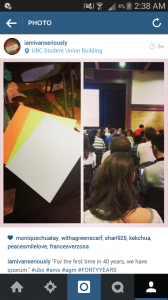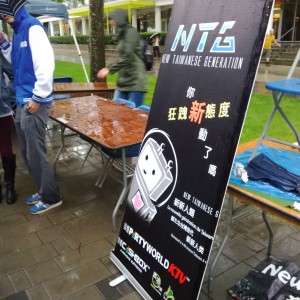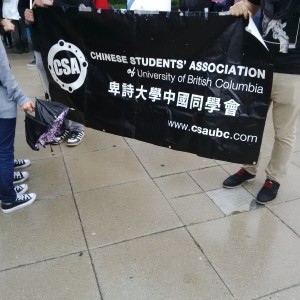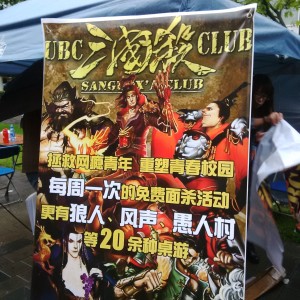I am always very reflexive (when the occasion calls for it — which is almost always, well, always) when I put myself into a discourse or a discussion. That means I am always, as I was trained to be, very aware of who I am and why my perspective would be what it is. For example, this is something I wrote for one of my papers for a university theory class:
Before I proceed with my essay, I will first take this time to position myself socially and be reflexive about my specific background. I am doing this as an exercise to act on my awareness that my personal subject-position has an effect in the production of knowledge that I will be endeavoring.
I am a Third-Year Arts student at the University of British Columbia majoring in Sociology. I am a Filipino-Chinese male who, at the moment, resides in Canada with a permanent resident status.
I am writing this essay with two main agendas: to fulfill an academic requirement for my Sociology class, and to be socially relevant – I am writing to bring attention to the presence of taken-for-granted realities that are responsible for propagating and perpetuating the inequality and oppression very much present today. (Arlantico 2013)
That’s the kind of awareness I have for my positionality — or, in other words, I am very much aware of the different identities I have and how they present themselves. For the most part, I always try to be as exhaustive as I can be when I position myself. TRY being the operative word, which means there are identities I often leave out — either accidentally or intentionally.
However, in my two-year stay at UBC so far, I’ve been to two distinct events when I was (almost) completely ONLY ONE THING: a UBC Student.
In September of 2013 I was a new transfer student to UBC — and of course, that meant I was attending Imagine Day. Imagine day was really fun. Tons of people everywhere, I get to see a really beautiful campus that I can call mine [sic], I’m meeting a lot of new and interesting people, and it marks a new chapter in my life. I was still very aware of who I was throughout that day though — I was a transfer student, I was a sociology major, I am an immigrant, and I am visibly Asian — as excited as I was to use the hashtag #IAMUBC, I was completely aware that I am not JUST a student at UBC, I am more distinct than that.
BUT… this happened:
and this…
Yup. PEP RALLY happened at the end of the day. The Thunderbird stadium, which can seat about 3500 people, was full of loud cheers, music, and a lot of of other really REALLY happy noise! I was in a sea of people all cheering for UBC! There were different rousing speeches made by different pertinent people in the university whose pertinence did not matter as much to me as their very inspiring speeches on #IAMUBC and how WE are UBC! Then there was an alumnus who did spoken word poetry on getting a degree, a couple of musical acts followed, and a WHOLE lot of cheering happened. Every faculty had their own color, own cheer, and occupied a distinct space in the auditorium; however, there was no other competing feel in the air: WE ARE UBC STUDENTS AND WE ARE DAMN PROUD THAT WE ARE.
That was instance one. The first instance in my UBC stay where I was nothing else other than — I AM UBC.
Fast forward a full year and a month — October 2014, this happened:
For the first time in 40 years, we have quorum.
Because of the proposed increased international student tuition and residence fees, UBC students banded together to show that we are AGAINST IT. (If you want to know more about the proposed fee increases, here is an article on The Talon about it, here is an article on The Ubyssey on the international tuition fee increase, and here is one on the residence fee increase also from The Ubyssey). For the first time in 40 years, YES, FORTY years, the AMS held an AGM and we had quorum — which means any and every decision made in that meeting was binding, WHICH in turn means that the AMS can say that the decisions and stances agreed upon during the meeting are representative of the whole student body.
Could you imagine being part of that? I was overwhelmed by the overall atmosphere in that room. Students were politically active! It did not matter who you were, at that very moment, you are a UBC student standing up for yourself and your fellow UBC student!
At that moment, I was nothing else but a UBC student — I am a student, I want my voice heard, and I am voting on these issues!
Reflecting back, the 2013 Pep Rally and the 2014 AMS AGM were two instances where I was solely a UBC student — which means, those were two instances where I was completely devoid of any other identity and social position other than those afforded to me as a UBC student.
Putting the spotlight on something inevitably casts shadows on some other things. Spotlighting my identity as a UBC student effectively erased all my other identities — at least in the brief moments when I had the spotlight on that particular identity. Often it’s not really about identifying with multiple things; I suggest that tackling identities — whether it be in your daily life or in an academic paper or class — should always be done by looking at the context through which those identities arose.
What does this mean? It means individuals and their (well, OUR) identities are products of the tension between the social and the personal — or as CW Mills will put it, the public and the private. Basically, following Mills’ idea of how personal troubles and never detached from public issues, we can never see ourselves apart from the social context within which we stand. That context could be as constant as your personal family history (where you were born and where you were raised) to something as fleeting as which seat on the bus you took and who sat beside you.
What am I getting at? Two things:
1. Our identities are closely tied in with our lived experiences and the contexts within which those experiences came about and are rooted in. That means, our identities are formed and understood through different contexts, AND the different expressions of our various identities are also understood through different contexts.
2. Every time a specific – -or some specific — identity of ourselves take the spotlight, some other identities are muted. Often, this is based on the context within which you express that certain identity.
So the next time you start your statement with “I am…” think of all the “I am not…” that come with it.
References:
CW Mills, The Promise (1959)





